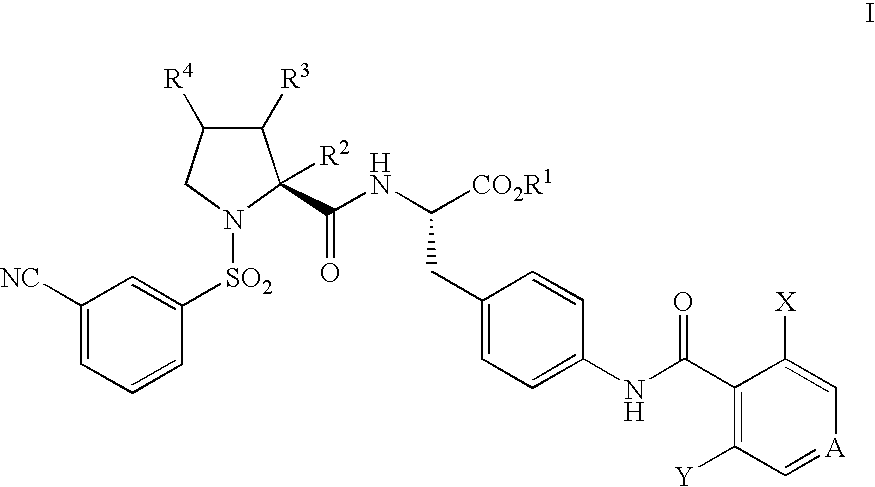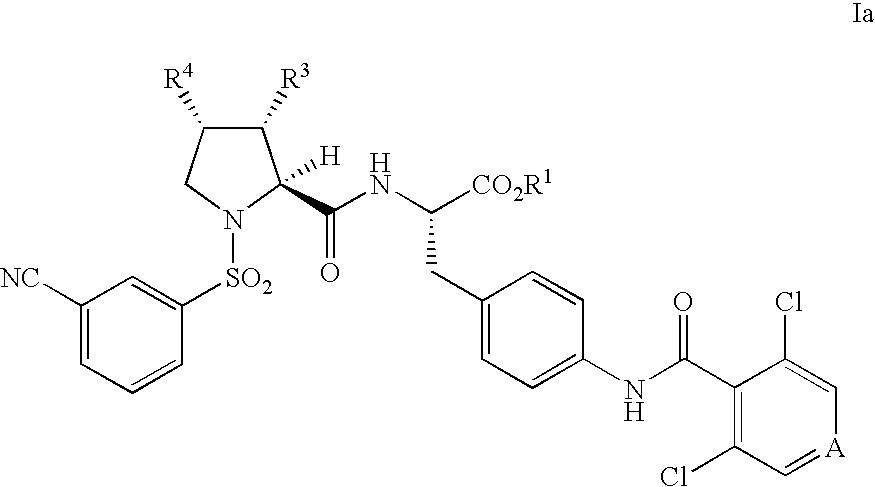Vla-4 antagonists
a technology of vla4 and antagonists, which is applied in the field of vla4 antagonists, can solve the problems of low oral bioavailability, unsuitable oral administration, and compound that was further characterized that demonstrated poor pharmacokinetic properties, and achieves significant and sustained receptor occupancy, slow dissociation rate (off-rate), and lymphocytosis.
- Summary
- Abstract
- Description
- Claims
- Application Information
AI Technical Summary
Benefits of technology
Problems solved by technology
Method used
Image
Examples
reference example 1
4-((3′,5′-Dichloroisonicotinoyl)amino)-(L)-phenylalanine, Ethyl Ester, HCl
[0094][0095] Step A: To 500 mL of absolute ethanol under nitrogen at 0° C. was added thionyl chloride (21 mL, 0.29 mol) over 5 min, and the clear solution was stirred at 0° C. for 10 min and then at rt for 30 min. 4-Nitro-L-phenylalanine (50.2 g, 0.24 mol) was added in one portion, and the mixture was refluxed overnight. The resulting mixture was concentrated in vacuo to give 4-nitro-L-phenylalanine, ethyl ester, HCl (60 g) as a white solid. 1H NMR (400 MHz, CD3OD) δ 8.21 (d, 2H), 7.54 (d, 2H), 4.39 (dd, 1H), 4.22 (q, 2H), 3.24-3.40 (m, 2M), 1.22 (t, 3H). [0096] Step B: To a suspension of the compound of Step A (60 g, 0.22 mol) in methylene chloride (1.5 L) under nitrogen was added TEA (31 mL). After stirring at rt for 10 min, di-t-butyl dicarbonate (49 g, 0.22 mol) and 4-DMAP (0.1 g) was added, and the reaction mixture was stirred at rt overnight, washed with 1N HCl (2×200 mL), H2O (2×200 mL) and brine (1×25...
reference example 2
N—BOC-cis-4-hydroxy-L-proline methyl ester
[0100][0101] Step A. A mixture of trans-4-hydroxy-L-proline (72.8 g, 0.56 mol), 2.5 M NaOH (480 mL, 1.20 mol, 2.18 eq), THF (100 mL), and di-tert-butyl dicarbonate (128 g, 0.58 mol, 1.07 eq) was stirred overnight at room temperature. The resulting white suspension was cooled to 0° C., acidified with conc HCl (105 mL, 1.26 mol, 2.29 eq), and extracted with CH2Cl2 (1×1L, 3×0.5 L) and ethyl acetate (2×1L). The combined organic extracts were dried with MgSO4, filtered and concentrated affording N-Boc-trans-4-hydroxy-L-proline as a viscous oil (146.3 g). The crude product (144.5 g, theory 0.56 mol), methyl iodide (100 mL, 1.6 mol, 2.90 eq), potassium carbonate (110 g, 0.8 mol, 1.42 eq) and acetone (2.5 L) were combined and the mixture refluxed for 4 hr. The reaction was allowed to cool to room temperature and stirred overnight. The mixture was filtered and the cake washed with acetone. The filtrate was concentrated, the residue dissolved in EtOA...
reference example 3
Methyl (4S)-1-[(3-Cyanophenyl)sulfonyl]-4-hydroxyprolinate
[0103]
[0104] Methyl (4S)-4-hydroxyprolinate (52.0 g, 0.286 mol) was dissolved in 500 mL CH2Cl2 and cooled to 0° C. Triethylamine (83.6 mL, 0.600 mol) was added, followed by 3-cyanobenzenesulfonyl chloride (55.0, 0.273 mol) slowly. The reaction mixture was stirred at room temperature overnight. Water was added, and the aqueous layer was extracted three times with CH2Cl2. The combined organic layers were washed with 1N HCl, H2O, 1N NaOH, and brine, dried over MgSO4, and concentrated to give a viscous residue. Ethyl acetate (300 mL) was added to completely dissolve the residue. Approximately 100 mL hexanes was added slowly until the solution became slightly cloudy. The mixture was then stirred overnight to allow the product to precipitate. The solid was filtered and rinsed two times with 30% EtOAc / hexanes to give the desired product as an off-white powder (66.2 g, 78%). 1H-NMR (CDCl3, 500 MHz) δ 8.20-8.18 (m, 1H), 8.15-8.12 (m,...
PUM
| Property | Measurement | Unit |
|---|---|---|
| weight | aaaaa | aaaaa |
| weight | aaaaa | aaaaa |
| weight | aaaaa | aaaaa |
Abstract
Description
Claims
Application Information
 Login to View More
Login to View More - R&D
- Intellectual Property
- Life Sciences
- Materials
- Tech Scout
- Unparalleled Data Quality
- Higher Quality Content
- 60% Fewer Hallucinations
Browse by: Latest US Patents, China's latest patents, Technical Efficacy Thesaurus, Application Domain, Technology Topic, Popular Technical Reports.
© 2025 PatSnap. All rights reserved.Legal|Privacy policy|Modern Slavery Act Transparency Statement|Sitemap|About US| Contact US: help@patsnap.com



